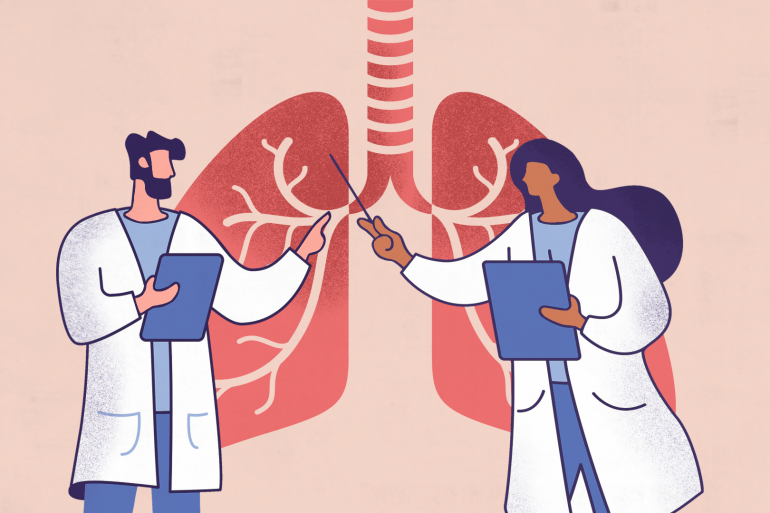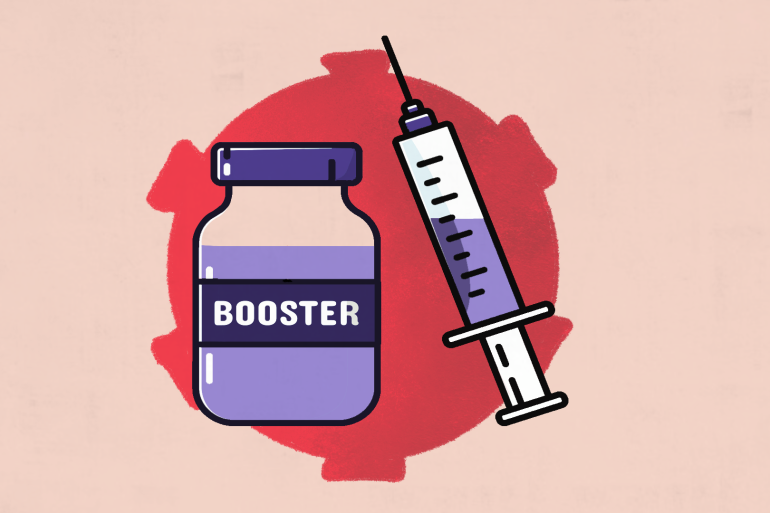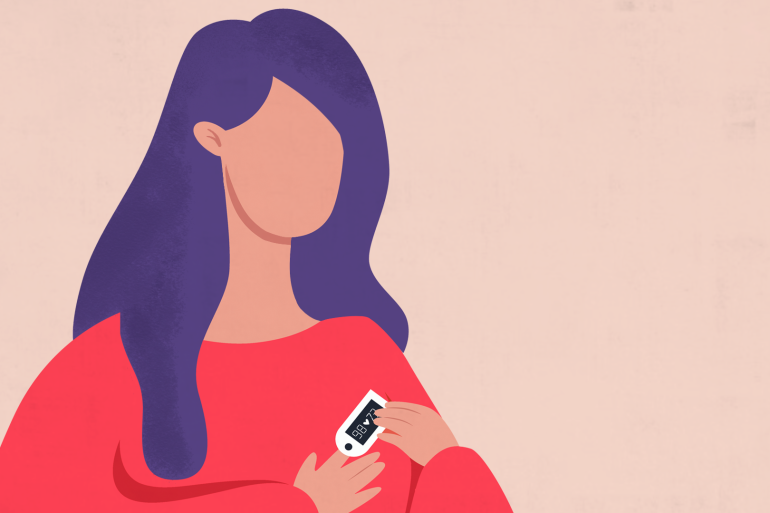Omicron is less severe because it does not infiltrate the lungs
Early laboratory studies show the more transmissible variant replicates less efficiently once inside the lung tissue. Plus, will we need second boosters, and how to manage COVID at home.

Scientists are using the word “milder” with much trepidation to describe the illness conferred by the Omicron variant of SARS-Cov-2. It is widely accepted that even if the variant is milder, the sheer number of people it infects might lead to more hospitalisations overall, with healthcare workers having to isolate due to testing positive.
Real-world data is still coming in about whether or not this variant does indeed cause a milder illness and carries a lower risk of hospitalisation, but early laboratory data on lung tissue in mice and hamsters may hold some of the answers.
Keep reading
list of 4 itemsLong COVID, rest, and helping our immune systems recover
Tumours disappear in all participants of small cancer drug trial
Can new Omicron subvariants evade vaccine immunity?
We already know that the Omicron variant harbours mutations that make it more transmissible. A team of researchers at Hong Kong University’s faculty of medicine found Omicron replicates 70 times faster than Delta in human airways. The study, which is yet to be peer-reviewed, showed that when compared with both Delta and the original coronavirus, the Omicron variant was much quicker at getting into the bronchus or tubes that run through the upper airways and lungs but much slower at infiltrating the lung tissue itself. According to the researchers, the Omicron variant replicated less efficiently, more than 10 times lower, once inside the human lung tissue than the original SARS-CoV-2 virus, which may suggest lower severity of disease.
It is hypothesised that serious illness from COVID-19 occurs once the virus gets into the lungs and spreads to other parts of the body from there, if it can be contained in the upper airways, the mouth, nose, etc, there is much less chance of severe disease.
However, the lead author Dr Michael Chan has urged caution over the findings. “It is important to note that the severity of disease in humans is not determined only by virus replication but also by the host immune response to the infection,” said Dr Chan.
Many of the COVID-19 hospitalisations have occurred not only because of the illness the virus causes but also because of the unpredictable nature by which our immune systems respond to the virus. In some cases, the immune system is unable to switch off and attacks not only the cells infected by the virus but the healthy cells, as well. Chan noted that a highly contagious virus like Omicron may cause more severe disease and death simply by spreading much faster, even though the associated lung infection appears not as bad.
A team studying the Omicron variant in Glasgow think they have found the answer as to why this variant is unable to infect the lung cells as much as it does the upper airways. They found an essential protein found on lung cells called TMPRSS2, which usually helped previous SARS-COV-2 variants to gain entry into the lung cells themselves bound less strongly to Omicron, meaning it was more difficult for this variant to get inside and infect lung cells.
The virus enters the cells lining the nose, throat and upper airways in a different way, so although it was found in high quantities in these parts of the airways, the concentration of the virus was lower in lung tissue. This might also partly explain why the Omicron variant is so transmissible, if it is concentrated in high quantities in the upper airways, viruses are more likely to be coughed, sneezed or breathed out from these parts of the airways and infect other people.
A combined American and Japanese study, which is still under peer review, looked at the effects of the Omicron variant in mice and hamsters. These rodents had the same ACE2 receptors that humans have and what the coronovairus binds to in order to enter and infect cells. The study found the rodents that were infected with Omicron had less lung damage, lost less weight and were less likely to die than those infected with Delta.
The studies offer some hope for a milder illness, but laboratory studies do not always translate into real-world data where more variables are involved. Data from South Africa, where the variant was first identified, continues to show no real increase in hospitalisations, but it is important to note that South Africa has a relatively young population. We are yet to see how the Omicron variant behaves in older people, indoor mixing during the Christmas and New Year period is likely to answer that question soon. It is also worth noting that schools across the world have been closed for the festive period but are due to open at the start of January, so children who have been drivers of infection in past waves will be exposed to the virus in classrooms and take it home to their families.
The UK has already started to see a sharp increase in hospitalisations due to coronavirus. The other sinister concern is Long COVID, when symptoms persist long after the virus has been cleared. And with so many people being infected with Omicron, we are likely to see more people affected by Long COVID.
As a doctor, I worry the implications of a milder illness may lull people into a false sense of security, perhaps make them less likely to wear a mask, socially distance or worse, take up the vaccine. We have become somewhat numb to the number of deaths from COVID-19. Milder or not, Omicron remains a serious global threat.
Progress report: Will we need a second booster?
It is clear that a booster dose of the COVID-19 vaccine after your initial doses offers good protection against serious illness from the Omicron variant.
Before Omicron, a one-booster dose of the vaccine was thought to be enough for the time being to keep protection at reasonable levels. Vaccines trigger different parts of the immune system, neutralising antibodies that kill the virus on arrival and stop it from infecting cells and crucially reducing risk of transmission of the virus. They also trigger longer-lasting B and T memory cells that offer longer-term protection by killing any cells that might be infected by the virus and preventing serious disease but not necessarily onward transmission.
But now, with Omicron, transmission of the virus is the main issue with huge numbers of people becoming infected and not only getting sick but also taking time off work. This means experts are more focused on those neutralising antibodies, which are crucial in reducing the spread of the virus in a bid to get numbers of people infected under control. However, a new study from the UK has suggested that these antibody levels may start to drop off 10 weeks after the booster.

Analysis by the UK Health Security Agency found that the booster dose’s ability to protect against Omicron was already beginning to wane in some people who took it more than 10 weeks prior. At this stage, its effectiveness in preventing symptomatic disease dropped by 15 to 25 percent. On the other hand, memory cells are likely to last longer, and continue to offer protection against serious illness but it remains unknown for how long and how effective they are likely to be.
Israel is taking no chances and has already started to offer a fourth dose or second booster to older and vulnerable groups in a bid to curb the spread of Omicron. Other countries are reviewing the data, but it is likely that many will offer a second booster dose in the latter half of this year.
At the same time, with this variant proving how quickly things can change, many vaccine manufacturers are now starting to develop Omicron-specific boosters; but this will take time and we must focus on containing the current surge in infections.
Many people will groan at the idea of another booster so close after their first one, and I understand this. But the truth is, variants will continue to emerge as long as vaccine inequity in the world remains. Poorer countries with fewer people vaccinated are more likely to provide the ideal conditions for new variants to arise, which will then spread rapidly throughout the world. Boosters are important, but so is getting a first and second dose into the arms of those living in poorer countries.
Wealthier nations continue to look inwards when it comes to COVID-19 and do all they can to protect their own populations, but the merry-go-round of new variants and further boosters will continue if they do not work together to vaccinate the wider world.
Good news: In the face of US sanctions, Cuba makes its own effective vaccine
When the pandemic began, Cuba recognised that the 60-year-long US economic sanctions against it would make it difficult to import COVID-19 vaccines to help protect its population – so it decided to manufacture its own.
Researchers at state-run biotechnology companies began developing COVID vaccines, and eventually, the Finlay Institute of Vaccines in Havana came up with the Soberana 02, which entered phase III clinical trials in March 2021.
To make Soberana 02, Finlay scientists combined fragments of the coronavirus spike protein with a deactivated form of tetanus toxin – the combination of which can boost production of immune cells and antibodies. The vaccine was approved for use in adults in Cuba in August 2021. Then in November, a study showed the Cuban-produced vaccine is more than 90 percent effective in protecting against a symptomatic COVID-19 infection when used in combination with a related vaccine.
Another Cuban-produced vaccine, Abdala, manufactured at the Centre for Genetic Engineering and Biotechnology (CIGB) has been found to be 92 percent effective at protecting against serious disease; the results of the phase III trials are yet to be published but the vaccines was given approval for use in adults in July 2021.
Both vaccines are also being given to children in Cuba and are currently being exported to other countries that are bound by US sanctions, including Venezuela and Iran.
Personal account: Managing COVID patients at home
When a patient presents with COVID-19-type symptoms, I have to assess them in order to decide whether or not their symptoms and risks are bad enough that they need hospital care, or whether they can be safely managed at home.
It is a tricky decision, mainly because we are dealing with a fairly new virus that not only presents in myriad ways, but also affects people differently. When the decision is made to manage the patient at home, I must put stringent safety nets in place so they can be monitored and can report any deterioration in symptoms.
I recommend all my patients to buy a pulse oximeter. This is a small device that clips onto the end of your finger and measures your oxygen levels and pulse rate. The cost of a pulse oximeter is between $20 and $50. COVID can damage the lungs and cause breathing problems, but this damage can be insidious. Blood oxygen levels can drop slowly so people may not notice as the body can acclimatise to slow reductions in oxygen; symptoms such as shortness of breath may not come on until it is too late.

A pulse oximeter, which can be purchased online or at most pharmacies, will measure these oxygen levels and warn both me and the patient if they fall dangerously low and alert them to seeking help. It is especially useful for those with underlying health conditions or people aged 60 or over, who test positive for COVID, as these groups are more at risk of serious illness.
Pulse oximeters measure blood oxygen as a percentage; for those with no underlying lung condition the normal values range from 94-100 percent. I advise the patient to seek medical help if their oxygen levels fall to between 93 and 94 percent, and seek emergency medical attention if the value drops below 92 percent. If a patient has an underlying health condition, then their normal values will vary and should be familiar to them. A drop of 3 percent from their normal levels should be reported to a medical professional.
The downside to pulse oximeters is that they are less accurate on pigmented or darker skin – the ugly side of racism in medicine rearing its head again – and they can give false reassurances to people in that case. I always warn my patients that their symptoms trump their readings, so if they feel worse and their oxygen readings are OK, they should still seek medical help.
I have had relative success with pulse oximeters and managing COVID patients at home. With more and more people becoming infected and healthcare systems being tested, if patients are safe to be managed at home and pulse oximeters help do this, then it is certainly worth a try.
Reader’s question: Does Omicron have new symptoms?
Symptoms of COVID-19 will vary from person to person, but what is becoming clear is that the original symptoms – high temperature/fever, a new persistent cough and a loss of sense of smell and taste – need an urgent update.
The ZOE COVID Study, a UK study that tracks numbers of people infected and their symptoms has been analysing data from people who have tested positive for Omicron in London. London was selected due to the higher prevalence of the variant compared with other regions in the UK.
The top five symptoms reported in the ZOE app were:
- Runny nose
- Headache
- Fatigue (either mild or severe)
- Sneezing
- Sore throat
Dr Angelique Coetzee, the South African doctor who first alerted the world to Omicron, has reported her Omicron-positive patients presenting with new symptoms including a scratchy throat, night sweats and extreme fatigue and muscle aches.
It is clear that symptoms for Omicron vary from the original three variants, so if we want to keep a track of numbers and help reduce the spread of the virus, we need people with the new symptoms to be able to test and isolate. Until this happens, we are likely to see an increasing spread of Omicron.